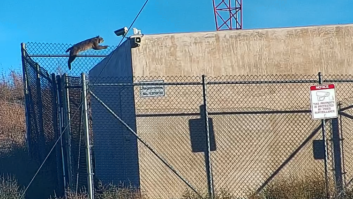Retired WFMT Chicago Chief Engineer Gordon Carter saw the Workbench column in the Feb. 17 issue and for a moment thought we had published an old picture from WFMT.
When the station moved to Illinois Center in the early 1980s, Gordon did something similar with his wire spools. At that time Gordon was doing a lot of building, and had on hand a 1,000-foot spool of each solid color of #22 stranded plus a 100-foot spool of each of the striped varieties. He also kept a few other frequently used spools. Gordon and his team used a full 10-foot length of conduit to hang all the spools in the engineering shop.
He offers a few tips for this kind of wire spool management setup.
First, make sure your brackets are anchored firmly to studs and not into drywall. Gordon tried some drywall anchors, which immediate pulled out when they put the wire spools on the conduit. In Gordon’s case, they had metal studs in the wall, so they actually used expanding anchors through the metal studs. Normal methods of anchoring to the metal stud just didn’t hold. Although the studs held firm, there just wasn’t enough support to keep the screws from pulling out.
Gordon found that if you pulled the wire off the spools too quickly, the spool would continue to spin, leaving several feet of wire on the floor. The hangers were high enough that he and his team could not reach the spools without a ladder, so it wasn’t practical to roll it back onto the spool. Instead, they found that wrapping the conduit (or at least the top surface of the conduit) with gaffer’s tape gave enough friction to control the spinning spools. Gordon advises not using duct tape, as it is too slippery and doesn’t provide the necessary friction. The cloth gaffer’s tape was the best thing they found for this job.
To help maintain some order, each spool of wire had a screw eye on the wall that the wire ran through. This helped keep the wire in sight and in order, so you can find the one you needed quickly. Gordon also went a step further and put a single larger screw eye on the wall a foot or so below the others. He used this to help when pulling several colors at the same time. You could pick the colors you wanted, and then thread them through the larger eye, so you were pulling all of the wires in the same direction. Gordon and his team found this especially helpful in cases where they needed wires that were not consecutive on the conduit.
Thanks, Gordon, for sharing your wire management techniques.
***

Fig. 1: An end cap screwed on the end of the support pipe would prevent the spindle from slipping off its support. Wolfram Engineering Principal Greg Muir also saw the closet hanger/wire spool tip and says he has used this approach on a few occasions. He even installed closet brackets to hold pipe on his patio to support hanging planters.
Greg noticed that Steve Smit had selected threaded steel pipe instead of conduit (Fig. 1). Greg has found that the friction caused by the heavier wooden wire spools sometimes has a tendency to rotate the pipe, causing it to “walk” off its respective hanger if no means to stop sideways movement is provided. The solution is to screw pipe caps on the ends.
In the case of conduit, I’ve seen engineers drill a hole through the end of the conduit and into the hanger, then insert a 2-inch bolt to keep the conduit in place.
***
Remember our Left-Hand/Right-Hand nut, also in the Feb. 17 column? Rod Simon, studio engineer for Moody Radio in Chicago, writes that he and several fellow students at Linn Tech designed a similar nut, along with a three-prong tuning fork, back around 1973. Or was it a Right-Hand/Left-Hand nut?
Either way, it’s good to see students using creativity in drafting class. Radio World Editor in Chief Paul McLane suggests you Google “impossible objects” and “impossible shapes” to see more fun stuff along those lines.
***

Fig. 2: Ensure tight set screws on phasor controls. Do you maintain an AM directional? When was the last time you checked your phasor cranks?
Check the crank and turns counter assemblies periodically, especially before any adjustment. Over time, the set screws that hold the crank assembly to the variable coil or capacitor shaft can loosen or slip. The result is that the turns counter displays a full turn of the phasor crank, but because of the slippage, the variable coil or capacitor turns only a fraction of a turn. Thus a phasor can get really fouled up, displaying turns counter numbers that have no relationship to how much the coil or capacitor was actually turned.
The solution requires an extra pair of eyes. With the transmitter off and using a strong trouble lamp, look to see that the adjustable component turns smoothly while another engineer turns the adjustment crank. Before you begin, record both the turns counter dial indication and the position of the adjustment arm.
Turn the crank one full turn in one direction, making sure there is no slippage, and then rotate the crank in the opposite direction, back to the starting point. Tighten the shaft setscrews if you note slippage.
Thanks to consultant R. Morgan Burrow, P.E., for the maintenance tips.
You have good ideas, we’re looking for good ideas. Send Workbench tips to [email protected]. Fax to (603) 472-4944. Bonus: Tips qualify for SBE recertification credit.
Author John Bisset has spent 46 years in the broadcasting industry. He handles West Coast sales for the Telos Alliance. He is SBE certified and is a past recipient of the SBE’s Educator of the Year Award.












